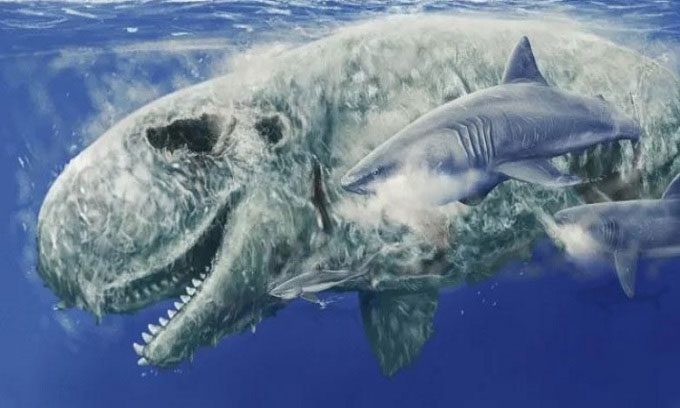Researchers have discovered that the ancestors of sharks had a strong preference for eating the noses of ancient sperm whales due to their high fat content, according to a study published in the Proceedings of the Royal Society B.

Simulation of a sperm whale carcass being eaten by sharks. (Photo: Jaime Bran)
Sperm whales possess large nasal organs rich in fat, which they use to produce sounds such as clicks and acoustic signals for echolocation. Aldo Benites-Palomino, a PhD student at the University of Zurich, and his colleagues analyzed bite marks on several fossilized sperm whale skulls from the Miocene epoch found in the Pisco Formation in Peru, dating back 5 to 7 million years. The bite marks corresponded to the jaws of various ancient shark species concentrated around the nasal area of the sperm whale skull, primarily in the upper jaw and around the eyes. This reveals the sharks’ preference for this part of the whale’s body.
“The nose of modern sperm whales is one of the most oil- and fat-rich parts of nature, belonging to the nasal complex,” Benites-Palomino noted.
While the fossilized sperm whale skulls contain no soft tissue due to the fat having decomposed over millions of years, the shape of the skull led the research team to infer that the noses of ancient sperm whales also contained fat, making them a perfect meal for sharks. “The sperm whale family is incredibly diverse, with at least seven known species from the Pisco region. They provided an ideal food source,” Benites-Palomino stated.
In modern times, sharks are also known for their preference for high-fat body parts, such as the blubber of dead whales. This study reveals that this preference has persisted for millions of years, with sharks identifying the nose as the richest source of fat on sperm whales.
Sharks do not typically hunt sperm whales for their noses but often consume their floating carcasses before they sink to the ocean floor. The carcasses can float for many days until all the fat has been consumed by the sharks, Benites-Palomino explained. According to the study, the shape, size, and tooth marks of the bites vary widely. The most common shark species living near Peru during that period included mako sharks, great whites, sand sharks, and the massive megalodon.


















































